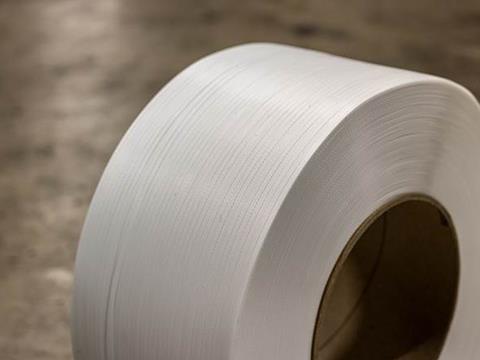
What does sustainability for consumable packaging mean in practice, what are the key drivers of innovation, and what might the future of the sector look like? Patrick Eggen of Signode tells us more in this edition of our ‘In Conversation With…’ feature.
To start with, could you tell us about the development of sustainability in the consumables space over the past few years? How different were things in the sector five or ten years ago?
Over the past few years, there has been a growing focus on sustainability in transit packaging for consumables, driven by a combination of environmental concerns and increasing customer demand for sustainable products. Some of the key developments in this area include:
- Use of eco-friendly materials: Many companies in transit packaging are now using eco-friendly raw materials such as post-customer recycled material or materials from biomasses. For many years, Signode has used 100% recycled PET flakes for their PET straps.
- Reduction of packaging waste: There is a growing trend towards reducing packaging waste through the use of more efficient designs and materials. For example, companies could be using thinner and lighter packaging materials to reduce the amount of waste generated during transit. Signode believes that, through collaboration with their packaging consultants, customers can optimize their packaging usage without sacrificing load integrity. With an approach that begins with an on-site audit to understand each operation’s unique challenges, Signode is proud to be a partner that understands and supports their customers sustainability goals while reducing costs.
- Adoption of reusable packaging: More and more companies are now adopting reusable packaging solutions as a way to reduce waste and improve sustainability. In Signode’s portfolio, this includes products such as reusable plastic tier sheets and crates.
Five years ago, the use of eco-friendly materials and the reduction of packaging waste were still relatively new concepts. Today these approaches are becoming standard practices. However, due to higher prices for more sustainable products, customers can be hesitant to fully switch away from the original products.
What are some of the key challenges associated with developing sustainable consumable packaging solutions?
There are several challenges Signode and its competitors face:
- Cost: Sustainable raw materials are more expensive than traditional raw material.
- Material availability: with raw material shortages across the globe, the scarcity and availability of sustainable raw materials can challenge the supply chain.
- Performance: for some specific packaging products such as stretch films, sustainable materials may not have the same chemical and/or mechanical properties. R&D, adapted recipes and in-depth lab and field tests must be conducted to deliver, at minimum, similar performance results.
- Pricing: Like every new technology or production process that involves significant changes in customer behavior, there is an early adoption period before the innovation becomes the new standard. Even if customers are interested in sustainable packaging solutions, the higher price this requires, for now, is not yet commonly accepted. However, all long-term indicators are clearly demonstrating that the change to widespread adoption will happen, and Signode is prepared for when that day comes.
- Regulatory environment: The regulatory environment around sustainability is complex and constantly evolving. Two years ago, the EU introduced a new plastic Tax; however, similar laws are not yet in effect in other countries across the globe. With a multitude of frequently changing regulations at national, regional and global levels, there is still a level of uncertainty that makes it difficult for companies to implement lasting sustainable practices.
Incorporating recycled material has become a central pillar of packaging sustainability in recent times. How is this manifesting in the consumables space?
Signode has set ambitious targets to innovate on sustainable packaging solutions. Innovation is happening in many areas – the raw materials we use for manufacturing, the suppliers we select for delivering and shipping materials, the production processes and facility infrastructures to optimize usage of resources, the consultation approach with customers to find the right solution balancing ecological and economical aspects, and more.
In any case, we are cultivating the mindset and behavior of employees to prioritize sustainability and look for ways to reduce environmental impact. It is not only about claiming our company is green – we have committed, invested and changed our way of thinking and acting at a global scale as one of the major industrial packaging producers. We are also part of the 20by30 program led by our parent company Crown Holdings, one of the most ambitious long-term sustainability plans in the packaging industry.
We’re seeing an increasing number of paper-based consumable innovations being announced in the sector. What are your thoughts on this trend – both from a sustainability and functionality point of view?
Every trend needs to be reflected upon before being introduced to an operation. For any material used for packaging solutions, companies should carefully consider the origin of the raw material, its environmental impact and its intended functionality. Using paper-based consumables can help reduce the use of non-renewable resources and promote a circular economy.

But the execution and reality of this full-circle aspiration will always depend on what the final receiver of goods does with the consumable. Is the end user throwing packaging into general waste or recycling? For any packaging product, this is the big question.
Paper-based innovations have happened in strapping and wrapping processes, primarily to replace plastic-based alternatives. This makes sense from a sustainability-only perspective, as paper is a renewable resource that can be sustainably sourced and recycled.
However, it’s important to note that paper-based products are not always the best solution for every application. From a functionality perspective, paper-based consumables do not and will not have the same material characteristics and technical performance as plastic. For this reason, the majority of applications in various industries cannot be replaced by paper.
Plastic has, in general, caught up with paper-based products on the grounds of recyclability and sustainability in the last few years. Leading innovations include biodegradability, PCR materials and improved quality of recycled materials to make plastic a valid and sustainable product.
Overall, the trend towards paper-based consumable innovations is a positive development that can help promote sustainability and improve functionality. Paper-based consumables can be used in conjunction with other sustainable materials, such as biodegradable coatings, to provide additional functionality and durability.
As a result, it is not about choosing paper or plastic as a unique way to solve everything, it is about being smart and resilient by combining the best of both worlds.
Simply put: what does the future hold for consumable packaging sustainability?
The future of consumable packaging sustainability is likely to be driven by several key trends, including:
- Increased use of recycled and sustainable materials: As customers and regulators continue to prioritize sustainability, companies will increasingly look for ways to incorporate recycled and sustainable materials into their packaging solutions.
- Adoption of circular economy principles: The concept of a circular economy, in which resources are kept in use for as long as possible, is likely to become more widespread in the packaging industry. This will involve a shift towards more closed-loop supply chains and a greater emphasis on reuse and recycling.
- Innovations in materials and technologies: Companies will continue to invest in research and development to create new sustainable materials and innovative packaging designs that are more environmentally friendly and functional. This trend can also apply to the technologies that apply the consumables to a load of goods, improving the sustainable impact on the process as a whole.
- Customer education and behavior change: Increasing customer awareness and education about sustainable packaging practices will help to drive demand for sustainable products and promote behavior change.
Overall, the future of consumable packaging sustainability is likely to be characterized by continued innovation and collaboration across the supply chain to create more sustainable, functional, and efficient packaging solutions to reduce waste and minimize environmental impact.
Pricing today may be a barrier to adoption for most customers, but this is a similar challenge that other industries have experienced over the last several decades when significant changes in sustainable practices are introduced. We are future enthusiasts that make no compromises in achieving our targets – improving sustainability is a must, not an option.
Patrick Eggen, VP of Global Marketing and Communications at Signode










